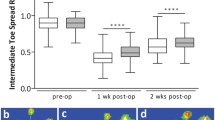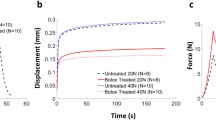Abstract
The aim of this study was to quantify the effect of chemically induced diabetes mellitus (DM) on the mechanical properties of the Achilles tendon of rats and correlate it with metabolic and biomechanical findings. Adult rats were selected randomly and assigned to two groups, the diabetic group consisted of animals receiving a dose of streptozotocin to induce type I diabetes and the control group. The animals were placed in metabolic cages for analysis of metabolism. Ten weeks after diabetes induction, the Achilles tendon of both groups were collected and submitted to a traction test in a conventional testing machine. The measurements of mechanical properties indicated that the elastic modulus (MPa) was significantly higher in the control group (p < 0.01). In Maximum tension (MPa), the groups did not have differences (p > 0.01). Energy/tendon area (N mm/mm2), specific strain (%) and maximum specific strain (mm) were higher in tendon tests of the diabetic group (p < 0.01). We observed that the mechanical properties of tendons have correlations with metabolic properties of the diabetic animals. These results showed that induced DM in rats have an important negative effect on the mechanical properties of the Achilles tendon.



Similar content being viewed by others
References
Akturk, M., et al. Thickness of the supraspinatus and biceps tendons in diabetic patients. Diabetes Care 25(2):408, 2002.
Akturk, M., et al. Evaluation of Achilles tendon thickening in type 2 diabetes mellitus. Exp. Clin. Endocrinol. Diabetes 115(2):92–96, 2007.
Almeida-Silveira, M. I., et al. Changes in stiffness induced by hindlimb suspension in rat Achilles tendon. Eur. J. Appl. Physiol. 81(3):252–257, 2000.
Andreassen, T. T., H. Oxlund, and C. C. Danielsen. The influence of non-enzymatic glycosylation and formation of fluorescent reaction products on the mechanical properties of rat tail tendons. Connect. Tissue Res. 17(1):1–9, 1988.
Aydeniz, A., S. Gursoy, and E. Guney. Which musculoskeletal complications are most frequently seen in type 2 diabetes mellitus? J. Int. Med. Res. 36(3):505–511, 2008.
Batista, F., et al. Achilles tendinopathy in diabetes mellitus. Foot Ankle Int. 29(5):498–501, 2008.
Biewener, A. A., and T. J. Roberts. Muscle and tendon contributions to force, work, and elastic energy savings: a comparative perspective. Exerc. Sport Sci. Rev. 28(3):99–107, 2000.
Biewener, A. A., et al. Muscle mechanical advantage of human walking and running: implications for energy cost. J. Appl. Physiol. 97(6):2266–2274, 2004.
Bobbert, M. F. Dependence of human squat jump performance on the series elastic compliance of the triceps surae: a simulation study. J. Exp. Biol. 204(Pt 3):533–542, 2001.
Bolton, N. R., et al. Computed tomography to visualize and quantify the plantar aponeurosis and flexor hallucis longus tendon in the diabetic foot. Clin. Biomech. (Bristol, Avon) 20(5):540–546, 2005.
Buchanan, C. I., and R. L. Marsh. Effects of long-term exercise on the biomechanical properties of the Achilles tendon of guinea fowl. J. Appl. Physiol. 90(1):164–171, 2001.
DiDomenico, L. A., K. Williams, and A. F. Petrolla. Spontaneous rupture of the anterior tibial tendon in a diabetic patient: results of operative treatment. J. Foot Ankle Surg. 47(5):463–467, 2008.
Giacomozzi, C., et al. Does the thickening of Achilles tendon and plantar fascia contribute to the alteration of diabetic foot loading? Clin. Biomech. (Bristol, Avon) 20(5):532–539, 2005.
Grant, W. P., et al. Electron microscopic investigation of the effects of diabetes mellitus on the Achilles tendon. J. Foot Ankle Surg. 36(4):272–278, 1997; (discussion 330).
Hof, A. L., J. P. Van Zandwijk, and M. F. Bobbert. Mechanics of human triceps surae muscle in walking, running and jumping. Acta Physiol. Scand. 174(1):17–30, 2002.
Legerlotz, K., et al. The effect of running, strength, and vibration strength training on the mechanical, morphological, and biochemical properties of the Achilles tendon in rats. J. Appl. Physiol. 102(2):564–572, 2007.
Lerco, M. M., et al. Caracterização de um modelo experimental de Diabetes Mellitus, induzido pela aloxana em ratos: estudo clínico e laboratorial. Acta Cir. Brasil. 18:132–142, 2003.
Loren, G. J., and R. L. Lieber. Tendon biomechanical properties enhance human wrist muscle specialization. J. Biomech. 28(7):791–799, 1995.
Magnusson, S. P., P. Hansen, and M. Kjaer. Tendon properties in relation to muscular activity and physical training. Scand. J. Med. Sci. Sports 13(4):211–223, 2003.
Monnier, V. M., R. R. Kohn, and A. Cerami. Accelerated age-related browning of human collagen in diabetes mellitus. Proc. Natl. Acad. Sci. USA 81(2):583–587, 1984.
Müller, S. S., et al. Análise comparativa das propriedades mecânicas do ligamento da patela e do tendão calcâneo. Acta Ortop. Brasil. 12:134–140, 2004.
Natali, L. H., et al. Efeitos da corrida em esteira em músculos sóleos de ratos encurtados por imobilização. Rev. Bras. Med. Esporte. 14(6):490–493, 2008.
Oxlund, H., R. Manthorpe, and A. Viidik. The biochemical properties of connective tissue in rabbits as influenced by short-term glucocorticoid treatment. J. Biomech. 14(3):129–133, 1981.
Papanas, N., et al. Achilles tendon volume in type 2 diabetic patients with or without peripheral neuropathy: MRI study. Exp. Clin. Endocrinol. Diabetes 117(10):645–648, 2009.
Ramirez, L. C., and P. Raskin. Diabetic foot tendinopathy: abnormalities in the flexor plantar tendons in patients with diabetes mellitus. J. Diabetes Complicat. 12(6):337–339, 1998.
Reddy, G. K., L. Stehno-Bittel, and C. S. Enwemeka. Glycation-induced matrix stability in the rabbit Achilles tendon. Arch. Biochem. Biophys. 399(2):174–180, 2002.
Roberts, T. J., and R. L. Marsh. Probing the limits to muscle-powered accelerations: lessons from jumping bullfrogs. J. Exp. Biol. 206(Pt 15):2567–2580, 2003.
Seynnes, O., et al. Training-induced changes in structural and mechanical properties of the patellar tendon are related to muscle hypertrophy but not to strength gains. J. Appl. Physiol. 107(2):523, 2009.
Simonsen, E. B., H. Klitgaard, and F. Bojsen-Moller. The influence of strength training, swim training and ageing on the Achilles tendon and m. soleus of the rat. J. Sports Sci. 13(4):291–295, 1995.
Szkudelski, T. The mechanism of alloxan and streptozotocin action in B cells of the rat pancreas. Physiol. Res. 50(6):537–546, 2001.
Unlu, Z., et al. Ultrasonographic evaluation of pes anserinus tendino-bursitis in patients with type 2 diabetes mellitus. J. Rheumatol. 30(2):352–354, 2003.
Viidik, A. The effect of training on the tensile strength of isolated rabbit tendons. Scand. J. Plast. Reconstr. Surg. 1(2):141–147, 1967.
Viidik, A., C. C. Danielson, and H. Oxlund. On fundamental and phenomenological models, structure and mechanical properties of collagen, elastin and glycosaminoglycan complexes. Biorheology 19(3):437–451, 1982.
Vlassara, H., R. Bucala, and L. Striker. Pathogenic effects of advanced glycosylation: biochemical, biologic, and clinical implications for diabetes and aging. Lab Invest. 70(2):138–151, 1994.
Acknowledgments
All authors provided concept, idea, research design, writing, and data analysis. We acknowledge the financial support provided by Conselho Nacional de Desenvolvimento Científico e Tecnológico (CNPq 477096/2008-5) and fellowship from the CAPES (Coordenação de Aperfeiçoamento de Pessoal de Nível Superior) to Mr. Oliveira.
Author information
Authors and Affiliations
Corresponding author
Additional information
Associate Editor Michael R. Torry oversaw the review of this article.
Rights and permissions
About this article
Cite this article
de Oliveira, R.R., de Lira, K.D.S., de Castro Silveira, P.V. et al. Mechanical Properties of Achilles Tendon in Rats Induced to Experimental Diabetes. Ann Biomed Eng 39, 1528–1534 (2011). https://doi.org/10.1007/s10439-011-0247-z
Received:
Accepted:
Published:
Issue Date:
DOI: https://doi.org/10.1007/s10439-011-0247-z




